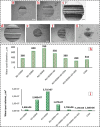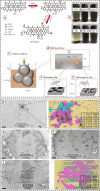Tribological Properties of Synthetic and Biosourced Lubricants Enhanced by Graphene and Its Derivatives: A Review
- PMID: 39758658
- PMCID: PMC11696415
- DOI: 10.1021/acsomega.4c06845
Tribological Properties of Synthetic and Biosourced Lubricants Enhanced by Graphene and Its Derivatives: A Review
Abstract
This review explores the tribological properties of biosourced lubricants (biolubricants) enhanced by graphene (Gr) and its derivatives and hybrids. Friction and wear at mechanical interfaces are the primary causes of energy loss and machinery degradation, necessitating effective lubrication strategies. Traditional lubricants derived from mineral oils present environmental challenges, leading to an increased interest in biolubricants derived from plant oils and animal fats. Biolubricants offer high biodegradability, renewability, and low toxicity, positioning them as ecofriendly alternatives. This work extensively reviews the role of Gr-based nanoadditives in enhancing the lubrication properties of biolubricants. Gr with its exceptional physicomechanical properties has shown promise in reducing friction and wear. The review covers various Gr derivatives, including Gr oxide (GO) and reduced Gr oxide (r-GO), and their performance as lubrication additives. The discussion extends to Gr hybrids with metals, polymers, and other 2D materials, highlighting their synergistic effects on the tribological performance. The mechanisms through which these additives enhance lubrication, such as the formation of protective films and improved interactions between lubricants and tribopairs, are examined. Emphasis is placed on the environmental benefits and potential performance improvements of Gr-based biolubricants. Finally, by analyzing current research and technological trends, the paper outlines future prospects for optimizing lubricant formulations with Gr-based nanoadditives, aiming for more sustainable and efficient tribological applications.
© 2024 The Authors. Published by American Chemical Society.
Conflict of interest statement
The authors declare no competing financial interest.
Figures








References
-
- Sun J.; Wang L.; Li J.; Li F.; Fang Y. An On-Line Imaging Sensor Based on Magnetic Deposition and Flowing Dispersion for Wear Debris Feature Monitoring. Mech. Syst. Signal Process. 2024, 212, 11132110.1016/j.ymssp.2024.111321. - DOI
-
- Ji R.; Zhao Q.; Zhao L.; Liu Y.; Jin H.; Wang L.; Wu L.; Xu Z. Study on High Wear Resistance Surface Texture of Electrical Discharge Machining Based on a New Water-in-Oil Working Fluid. Tribol. Int. 2023, 180, 10821810.1016/j.triboint.2023.108218. - DOI
Publication types
LinkOut - more resources
Full Text Sources
